Last week was the national geology conference in Estremoz, held in the town theatre and the old convent and run by the government and the universities. For those who are not geologists/academics looking at this photo imagining afternoon beers in the garden and lunch/dinner under the cloisters instead of learning are all you need before you read the next post or the next blog :) 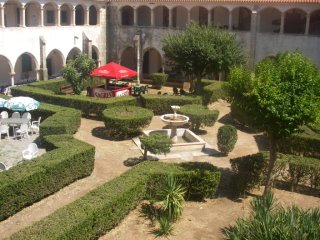 The programme was made up mostly of research in Portuguese geology - structural geology, stratigraphy, tectonic evolution, geochemistry (dating, isotopic data), fossils/sedimentology. A half day of "Resources Geology" included 90% of the talks on mineralisation, uniquely these included talks on ornamental stone (marble) and economic clay/feldspar deposits. More time was spent on environmental geology and "surface processes". Understandable given that this was a scientific conference not a industry or resources-focused conference, but economic geology still makes up a large part of scientific conferences in Australia, especially the national ones. Also these conferences attract more national/international scientists so talks will cover a variety of locations if not different branches of the science. But Portugal is not a large country, and therefore this was similar to some of the smaller state geology conferences.
The programme was made up mostly of research in Portuguese geology - structural geology, stratigraphy, tectonic evolution, geochemistry (dating, isotopic data), fossils/sedimentology. A half day of "Resources Geology" included 90% of the talks on mineralisation, uniquely these included talks on ornamental stone (marble) and economic clay/feldspar deposits. More time was spent on environmental geology and "surface processes". Understandable given that this was a scientific conference not a industry or resources-focused conference, but economic geology still makes up a large part of scientific conferences in Australia, especially the national ones. Also these conferences attract more national/international scientists so talks will cover a variety of locations if not different branches of the science. But Portugal is not a large country, and therefore this was similar to some of the smaller state geology conferences.
Having been in industry for a while "academic" geology is a little frustrating, Differences in opinion in geology are normal as its an interpretative science, but because academia involves researching in schools new data is often taken to prove or disprove that groups theories instead of leading to new conclusions. Such proof is essential not only in the dash for government grants but also in continuing age-old academic battles about where to draw the line in the sand (literally in geology!). In industry we have the advantage that interpretation is essential but we don't have to prove or disprove our own, if it turns out not to work then we try another way. Often we can test two or three different interpretations in one work programme, and because our aim is a resource then the assays, the numbers are hard proof of what's right or wrong. So going back to watching arguments about how old this formation is or when this tectonic event ended or sitting through Powerpoint slide after (not viewer friendly) slide of geochemical/isotope data without any apparently conclusions makes you want to scream. Or bunk off and have a beer in the square!
 It can also go over a simple rig geo's head talking about supercontinents, Wilson cycles and thermal gradients. But the big picture, the talk of how our world developed, evolved and is changing today can spark you too. I got to hear Antonio Ribeiro, the inspiration for much of Portugal's geologists/research today, photographed above as he transformed from stooping, grey mustached elderly man into an arm-waving prophet, animated by the force of his ideas. It was the presentation you expect from an elder statesman, a million OHPs whipped off the projector almost as fast as they were placed there, usually upside down/the wrong way round, faded photos of different outcrops/cliffs, hand-drawn diagrams, images photocopied from different papers and even magazines.
It can also go over a simple rig geo's head talking about supercontinents, Wilson cycles and thermal gradients. But the big picture, the talk of how our world developed, evolved and is changing today can spark you too. I got to hear Antonio Ribeiro, the inspiration for much of Portugal's geologists/research today, photographed above as he transformed from stooping, grey mustached elderly man into an arm-waving prophet, animated by the force of his ideas. It was the presentation you expect from an elder statesman, a million OHPs whipped off the projector almost as fast as they were placed there, usually upside down/the wrong way round, faded photos of different outcrops/cliffs, hand-drawn diagrams, images photocopied from different papers and even magazines.
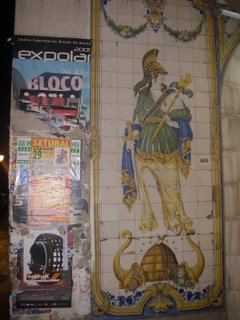



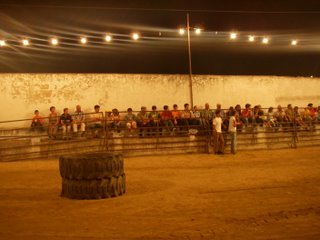
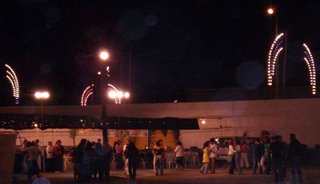


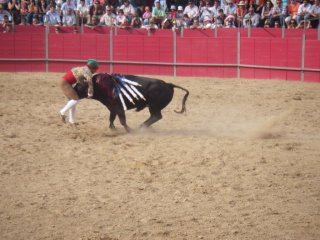 Bullfights are not just the pega. As was explained to me at the bullfight I watched “there are some tasks to be undertaken with the bull”. Mostly involving a guy on a horse riding around poking spears into the bull and then riding around the ring to lap up the adulation. It becomes mesmerising, with the pomp and ceremony, a glimpse of an ancient and primitive world. As a spectacle it’s at its best in the early stages, when the bull is racing around the ring like someone’s pulled his tail and ran away. Later on when the bull has been injured more and becomes tired and afraid the cruelty of it does hit home, as if on cue the brass band starts up to provide some entertainment and tell the cavaleiro to hurry up and get it over with.
Bullfights are not just the pega. As was explained to me at the bullfight I watched “there are some tasks to be undertaken with the bull”. Mostly involving a guy on a horse riding around poking spears into the bull and then riding around the ring to lap up the adulation. It becomes mesmerising, with the pomp and ceremony, a glimpse of an ancient and primitive world. As a spectacle it’s at its best in the early stages, when the bull is racing around the ring like someone’s pulled his tail and ran away. Later on when the bull has been injured more and becomes tired and afraid the cruelty of it does hit home, as if on cue the brass band starts up to provide some entertainment and tell the cavaleiro to hurry up and get it over with.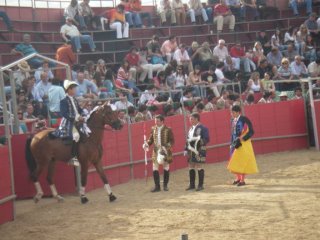 The truly amazing part is the horses – not only are they beautiful and groomed for the occasion, but the way they can bend and swerve (like Juddy!), even dance, and show no fear with a bull in front of them is breathtaking. Here then is horsey pics/p0rn for those who appreciate such things.
The truly amazing part is the horses – not only are they beautiful and groomed for the occasion, but the way they can bend and swerve (like Juddy!), even dance, and show no fear with a bull in front of them is breathtaking. Here then is horsey pics/p0rn for those who appreciate such things.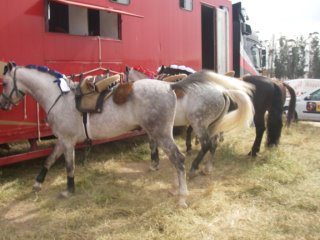 Yes my mind is turning back to Australia at the moment but even at the time it struck me of the similarity between bullfights and cricket games. Not just the arena ringed with a beer-drinking crowd roaring at something which didn't seem that interesting. Most of the Portuguese I talked to mostly went to and enjoyed bullfights as kids, usually with their dad/grandfathers, now they’re older it’s not so cool and they don’t enjoy it as much because they understand the cruelty (OK not so similar to cricket there), but they also see the tradition as valuable and admit they will probably take their kids/grandkids. The trend among 20-30 year olds at the moment is it's “cool” to be traditional, to enjoy traditional food, Portuguese beer, and enjoy bullfighting. I’m reminded of the fake country boys in Perth, in immaculately pressed moleskins and Country Road flannelette shirts talking about a land they’d never had to work, about roo-shooting they’d never had to do to protect a farm. The Portuguese guys even dress in flannies too.
Yes my mind is turning back to Australia at the moment but even at the time it struck me of the similarity between bullfights and cricket games. Not just the arena ringed with a beer-drinking crowd roaring at something which didn't seem that interesting. Most of the Portuguese I talked to mostly went to and enjoyed bullfights as kids, usually with their dad/grandfathers, now they’re older it’s not so cool and they don’t enjoy it as much because they understand the cruelty (OK not so similar to cricket there), but they also see the tradition as valuable and admit they will probably take their kids/grandkids. The trend among 20-30 year olds at the moment is it's “cool” to be traditional, to enjoy traditional food, Portuguese beer, and enjoy bullfighting. I’m reminded of the fake country boys in Perth, in immaculately pressed moleskins and Country Road flannelette shirts talking about a land they’d never had to work, about roo-shooting they’d never had to do to protect a farm. The Portuguese guys even dress in flannies too.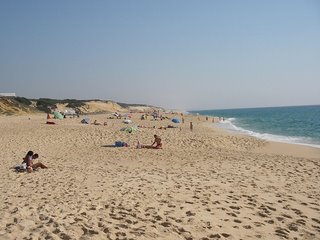
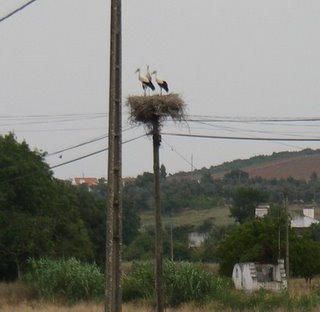
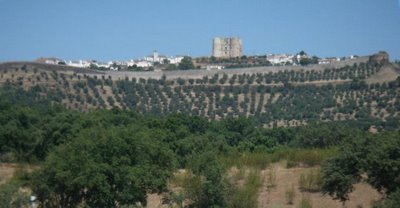


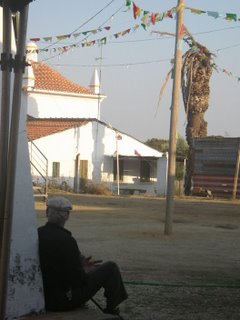
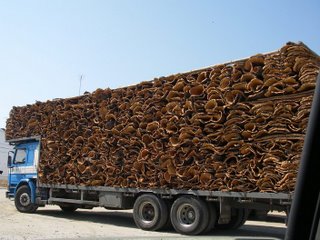
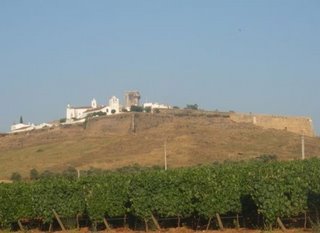 and the fact it has one of the biggest main squares in the country:
and the fact it has one of the biggest main squares in the country: Along one side of the square is the church above, along the other the old Convent (now a science museum), the Army barracks opposite the church and on the last side is a line of cafes perfect for having a beer in the shade on a hot day when you're bunking off a conference (more on that later):
Along one side of the square is the church above, along the other the old Convent (now a science museum), the Army barracks opposite the church and on the last side is a line of cafes perfect for having a beer in the shade on a hot day when you're bunking off a conference (more on that later):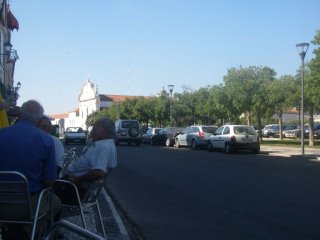
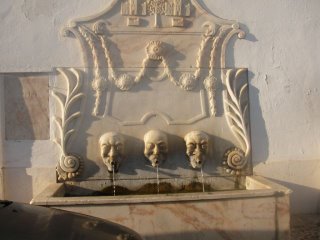 Estremoz is the first time I've been in a Portuguese theatre, while this one has renovated with unpolished marble (radical!) it still retains the gold trim and painted ceiling. The family name and portrait painted on their theatre box (as seen on the upper level of
Estremoz is the first time I've been in a Portuguese theatre, while this one has renovated with unpolished marble (radical!) it still retains the gold trim and painted ceiling. The family name and portrait painted on their theatre box (as seen on the upper level of 

